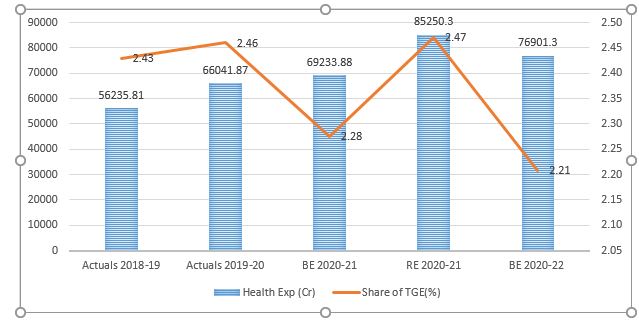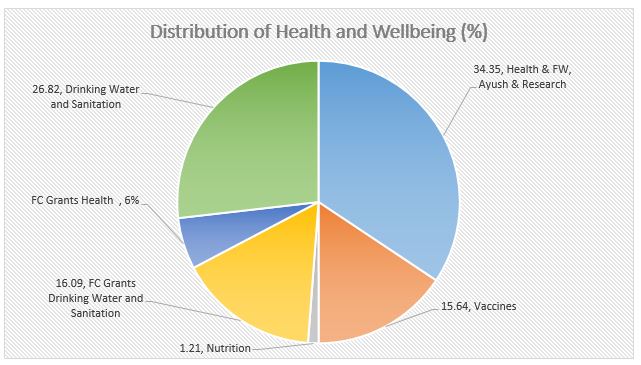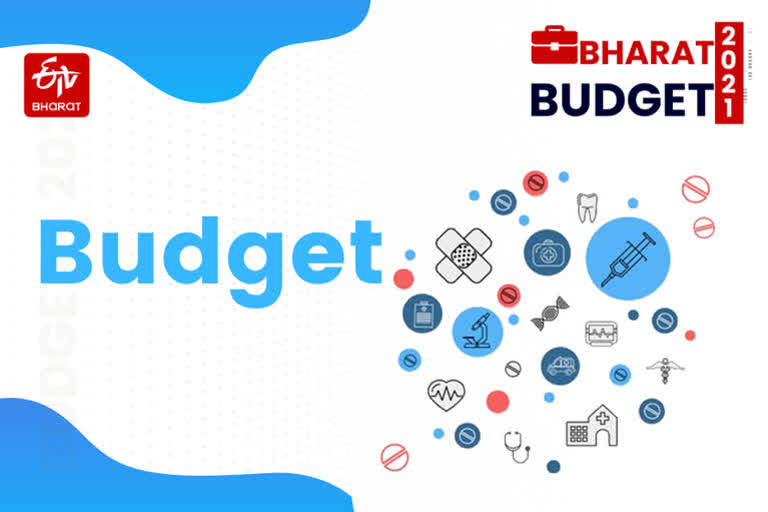Hyderabad: Covid 19 pandemic has produced twin problems to the national economy – economic downturn hitting the revenue generation and higher investment requirement in the social sector including health and social safety net programmes. Balancing between the two is a gargantuan task, often guided by fiscal prudency norms, however, the union budget has taken a mid-path. Underspending on health though has been a perpetual problem in India, COVID 19 however, has accentuated the need for higher public investment on health to plug the loopholes of health systems. Irrespective of the developed or developing state, everyone witnessed the hit of the pandemic, furthered more due to ill-preparedness of the health systems.
In 2021-22 BE, the finance minister has provisioned INR 76,901 cr for the department of health and family welfare, health research and Ayush ministry together, which is 11 % more than the previous year’s budget estimate. This is the highest increment in the last four years, however, its share in total government expenditure has remained more or less constant and stands at 2.21 per cent, similar to the 2020-21 BE.
An intra allocation shows 71,268 cr for health and family welfare department, 9 % modest rise from the last budget, and approximately 2970 cr for AYUSH and INR 2663 cr for the health research department.
Overall the share of health at meagre 2.21% in total government expenditure in this year’s budget may not alleviate the financial burden among households who spend a huge amount of money at the point of care. Total out of pocket expenditure stands at 63% which is not only regressive but pushes millions of people to poverty.
Expenditure on Health and Family welfare, Ayush and Health Research

A commendable announcement is PMAtamNirbhar Swasth Bharat Yojana declared under Health and wellbeing, one of the six pillars of achieving growth and Atma Nirbhar Bharat. An allocation of 64,180 cr for a period of six years with support to rural and urban health and wellness centres, setting up public health labs, operationalization of public health units at the air and seaports and strengthening national centre for diseases control are among an array of measures intended to strengthen primary care and promote public health activities.
A stark reality that the COVID pandemic has shown us is that if we do not invest more on basic healthcare, surveillance systems, and public health functions, the damage would be enormous. In this context, these measures are in the right direction to help manage and control the re-emergence of communicable diseases.
However, resource allocation may not be adequate and is thinly spread across a number of programmes. Additionally, INR 35,000 cr has been allocated for COVID vaccination programme which sounds rationale as it could vaccinate a substantial section of the population.
READ: Health budget could have been increased, says health expert
The sooner we vaccinate, better it would be for the economy as more and more people would be free to participate in the productive activities and contribute to economic growth.
Furthermore, this budget has allocated a substantial amount of money to social determinants of health – nutrition, drinking water and sanitation programmes which is a major part of health and wellbeing. Overall allocation to drinking water and sanitation has gone up considerably to INR 60,030 from INR 21,518 cr during 2020-21 BE and this is almost 3 times higher than the previous budget estimate.
On the contrary, there has been less allocation towards nutrition compared to last year’s budget estimate. Given the level of budgetary allocations in this year, India’s progress towards nutritional indicators as revealed from NFHS V needs to be contextualized. Especially, it is intriguing to understand what went wrong and why stunting –height for age and wasting –weight for height declined in most of the prosperous states of India.
The announcement of Mission Poshan 2.0 in this budget may be a big boost to the nutrition sector, however, it is too early to comment.

Moreover, the distribution of allocations on health and wellbeing that draws everyone’s attention indicates health gets around 40 % adding the finance commission grants and the share of drinking water and sanitation is quite large at 43%. 137% increase for health and wellbeing considered as quantum jump is not for health alone but covers social determinants of health.
Health is one of the important pillars and the priorities should not be out-of-place as the health care challenges are many-folded. In 2018, the announcement of PMJAY brought health to the centre of political discourse and 2020 health was again at the limelight for a wrong reason. The momentum should not be halted and public financing should be stepped up so that achieving the target of public spending to 2.5 -3% of GDP as mentioned in the Economic survey. India’s tag as a low public financier for health compared to many developing and developed countries of the world should be reversed as this is one of the reasons for the debilitating public health system of the country.



